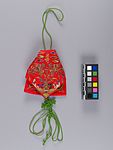wang-ga-yong-joo-mo-ni (Waist Bag)
About this object
History of use
Although such bags were used by both men and women, bags with these colours and decorations were used by women. Before western influences reached Korea, clothing did not have pockets, and such bags were used to carry small articles. They were attached to the waist ties of women’s skirts (chima) or men’s pants ( ). As they hung outside their clothes, they looked colourful and pretty, and their functions were more decorative than practical. They were the only decorations on people’s clothing. The decorations were royal prerogatives, although they eventually also became luxury items for high-class people. Kings and queens sometimes presented them to their family members to wish them good fortune and long life, and to exorcise evil influences. After the opening of Korea to the outside world in the late 19th century, they began to disappear from use, as people could then have pockets. Young female students liked to have them even after the modernization of Korea, as their teachers admired them. Bags as elaborate as this one were probably from the palace, and belonged to princesses. They might have been court wedding gifts. Such bags were made by court maids, “ja-su-sang-goong” (literally: embroidery court lady). They may have been used to hold talismans, cigarettes, or small items of jewellery.
Iconographic meaning
Specific techniques
The red silk comprising the outside of the bag was embroidered and couched, and cut into the shape that would form the bag. With the embroidered side facing in the outside was sewn to the lining, with the interfacing in place. The bag was then turned right-side out through a small hole and folded into shape, after which it was laced together and the cord knotted elaborately.
Physical description
A small flat bag made of red silk damask lined with dark blue silk damask with an inner lining of pink cotton fabric revealed by holes under the flap. Bag is rectangular with rounded sides narrowing through, folding to the top opening which is covered by a downwardly-extending flared flap ending with a point. There are embroidered designs outlined in heavy gold couching over the entire red surface. On the flap, there are stylized rocks and waves with a coin in the centre, above which, there are two phoenixes facing each other. Above that, there is a Korean? character with cloud forms on both sides. On the front of the bag, there are two floral images showing beyond the edges of the flap. On the back, there are two seams and four floral images. A green cord, ending in an elaborate knot and four loops, is threaded through the top of the bag. A loop fastener is under the flap.
Categories
Materials
Date Made
Before 1939
Date Acquired
Aug 1964
How Acquired
Donated
Credit Line
Measurements
Overall: 10.9 cm x 10.1 cm x 3 cm
Object Number
N3.3
